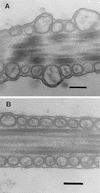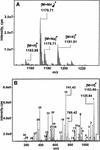A novel sensitive bioassay for detection of Bacillus cereus emetic toxin and related depsipeptide ionophores
- PMID: 9546170
- PMCID: PMC106152
- DOI: 10.1128/AEM.64.4.1338-1343.1998
A novel sensitive bioassay for detection of Bacillus cereus emetic toxin and related depsipeptide ionophores
Abstract
Of the toxins produced by Bacillus cereus, the emetic toxin is likely the most dangerous but, due to the lack of a suitable assay, the least well known. In this paper, a new, sensitive, inexpensive, and rapid bioassay for detection of the emetic toxin of B. cereus is described. The assay is based on the loss of motility of boar spermatozoa upon 24 h of exposure to extracts of emetic B. cereus strains or contaminated food. The paralyzed spermatozoa exhibited swollen mitochondria, but no depletion of cellular ATP or damage to plasma membrane integrity was observed. Analysis of the purified toxin by electrospray tandem mass spectrometry showed that it was a dodecadepsipeptide with a mass fragmentation pattern similar to that described for cereulide. The 50% effective concentration of the purified toxin to boar spermatozoa was 0.5 ng of purified toxin ml of extended boar semen-1. This amount corresponds to 10(4) to 10(5) CFU of B. cereus cells. No toxicity was detected for 27 other B. cereus strains up to 10(8) CFU ml-1. The detection limit for food was 3 g of rice containing 10(6) to 10(7) CFU of emetic B. cereus per gram. Effects similar to those provoked by emetic B. cereus toxin were also induced in boar spermatozoa by valinomycin and gramicidin at 2 and 3 ng ml of extended boar semen-1, respectively. The symptoms provoked by the toxin in spermatozoa indicated that B. cereus emetic toxin was acting as a membrane channel-forming ionophore, damaging mitochondria and blocking the oxidative phosphorylation required for the motility of boar spermatozoa.
Figures


Similar articles
-
In vitro assay for human toxicity of cereulide, the emetic mitochondrial toxin produced by food poisoning Bacillus cereus.Toxicol In Vitro. 2003 Oct-Dec;17(5-6):737-44. doi: 10.1016/s0887-2333(03)00096-1. Toxicol In Vitro. 2003. PMID: 14599471
-
Ionophoretic properties and mitochondrial effects of cereulide: the emetic toxin of B. cereus.Eur J Biochem. 1999 Jul;263(1):112-7. doi: 10.1046/j.1432-1327.1999.00476.x. Eur J Biochem. 1999. PMID: 10429194
-
Sperm bioassay for rapid detection of cereulide-producing Bacillus cereus in food and related environments.Int J Food Microbiol. 2004 Jul 15;94(2):175-83. doi: 10.1016/j.ijfoodmicro.2004.01.018. Int J Food Microbiol. 2004. PMID: 15193804
-
Why be serious about emetic Bacillus cereus: Cereulide production and industrial challenges.Food Microbiol. 2020 Feb;85:103279. doi: 10.1016/j.fm.2019.103279. Epub 2019 Jul 26. Food Microbiol. 2020. PMID: 31500702 Review.
-
Analytical methods for Bacillus cereus and other Bacillus species.Int J Food Microbiol. 1990 Mar;10(2):125-41. doi: 10.1016/0168-1605(90)90061-9. Int J Food Microbiol. 1990. PMID: 2119209 Review.
Cited by
-
Rapid Ped-2E9 cell-based cytotoxicity analysis and genotyping of Bacillus species.J Clin Microbiol. 2005 Dec;43(12):5865-72. doi: 10.1128/JCM.43.12.5865-5872.2005. J Clin Microbiol. 2005. PMID: 16333068 Free PMC article.
-
Identification and partial characterization of the nonribosomal peptide synthetase gene responsible for cereulide production in emetic Bacillus cereus.Appl Environ Microbiol. 2005 Jan;71(1):105-13. doi: 10.1128/AEM.71.1.105-113.2005. Appl Environ Microbiol. 2005. PMID: 15640177 Free PMC article.
-
Quantitative analysis of cereulide toxin from Bacillus cereus in rice and pasta using synthetic cereulide standard and 13C6-cereulide standard - a short validation study.Toxins (Basel). 2014 Dec 11;6(12):3326-35. doi: 10.3390/toxins6123326. Toxins (Basel). 2014. PMID: 25514093 Free PMC article.
-
Quantitative analysis of cereulide, the emetic toxin of Bacillus cereus, produced under various conditions.Appl Environ Microbiol. 2002 May;68(5):2479-83. doi: 10.1128/AEM.68.5.2479-2483.2002. Appl Environ Microbiol. 2002. PMID: 11976124 Free PMC article.
-
Mitochondrial toxicity of triclosan on mammalian cells.Toxicol Rep. 2015 Apr 7;2:624-637. doi: 10.1016/j.toxrep.2015.03.012. eCollection 2015. Toxicol Rep. 2015. PMID: 28962398 Free PMC article.
References
-
- Agata N, Mori M, Ohta M, Suwan S, Ohtani I, Isobe M. A novel dodecadepsipeptide, cereulide, isolated from Bacillus cereus causes vacuole formation in HEp-2 cells. FEMS Microbiol Lett. 1994;121:31–34. - PubMed
-
- Agata N, Ohta M, Masashi M, Isobe M. A novel dodecadepsipeptide, cereulide, is an emetic toxin of Bacillus cereus. FEMS Microbiol Lett. 1995;129:17–20. - PubMed
-
- Akiyama N, Mitani K, Tanaka Y, Hanazono Y, Motoi N, Zarcovic M, Tange T, Hirai H, Yazaki Y. Fulminant septicemic syndrome of Bacillus cereus in a leukemic patient. Intern Med. 1997;36:221–227. - PubMed
-
- Andersson M, Katila T. The Hague Congress proceedings 4. The 12th International Congress in Animal Reproduction, The Hague, The Netherlands, 23 to 27 August 1992. 1992. Evaluation of frozen-thawed stallion semen with a motility analyzer; pp. 1837–1839.
Publication types
MeSH terms
Substances
LinkOut - more resources
Full Text Sources
Other Literature Sources
Molecular Biology Databases

